Scientist & intelligence officer Sean Kirkpatrick picked to head the new Pentagon-IC office empowered by Congress to study Unidentified Aerial Phenomena

By Douglas Dean Johnson
@ddeanjohnson on Twitter
"I have to be able to see and metaphorically hear everything that’s going on between 100 kilometers off the face of the planet to wherever we are, and right now we can’t do that." – Sean Kirkpatrick, Ph.D., April 13, 2021
"Unlike physics, intelligence is not an exact science. But, like systems engineering, there is a lot of art and science mixed together." – Sean Kirkpatrick, Ph.D., 2016
"Brings unconventional thinking through a diverse background to solve some of the Nation's most complex and challenging problems....Change agent with deep experience in startup organizations and major organizational and management realignments." – LinkedIn.com profile for Sean Kirkpatrick, Ph.D., May 10, 2022
WASHINGTON [May 12, 2022, 4:00 PM EDT (8:00 PM GMT)] [Updated July 20, 2022, 11:30 PM GMT] – Senior Department of Defense and Intelligence Community officials apparently have picked a physicist with decades of experience in the Intelligence Community to serve as director of the recently elevated Pentagon office empowered by Congress to get a grip on Unidentified Aerial Phenomena (UAP).
Multiple Executive Branch branch sources, none able to speak on the record, have affirmed that Sean Kirkpatrick, Ph.D., applied to be the director of the recently created office that the Pentagon hierarchy calls the Airborne Object Identification and Management Synchronization Group (AOIMSG), and they say that Dr. Kirkpatrick has been selected to fill that position.
This article is the first public report regarding Dr. Kirkpatrick's apparent selection to head the new UAP office. The Pentagon has not confirmed this information. My inquiry to Defense Department spokesperson Susan Gough on May 10, 2022, specifically referring to Dr. Kirkpatrick, brought this response: "We have nothing to announce on the AOIMSG at this time." Now, you wouldn't be reading this if I wasn't pretty sure that I have it right – but if I miss the mark, your money back, no questions asked.
[UPDATE: July 20, 2022: The Pentagon issued a press release stating that Under Secretary of Defense for Intelligence and Security Ronald S. Moultrie "named Dr. Sean M. Kirkpatrick, most recently the chief scientist at the Defense Intelligence Agency's Missile and Space Intelligence Center, as the director of [the Pentagon UAP office]." A linked one-page bio of Dr. Kirkpatrick said, "Dr. Kirkpatrick was asked by USD(I&S) to stand-up and lead [the Pentagon UAP office] in early 2022." The release also noted that Dr. Kirkpatrick is "known as Dr. K to his staff and team."]
I do not know whether Dr. Kirkpatrick is yet formally in place, or whether he will be among the Pentagon officials available for questioning by members of the Subcommittee on Counterterrorism, Counterintelligence, and Counterproliferation of the House of Representatives Permanent Select Committee on Intelligence (HPSCI) on May 17, 2022, either during the subcommittee's open public hearing on Unidentified Aerial Phenomena (which will be the first open congressional hearing on the subject in more than 50 years), or in a closed, classified session that will follow.
[UPDATE, May 17, 2022, 4:30 PM EDT: In testimony May 17, 2022 at an open hearing before a subcommittee of the U.S. House of Representatives Permanent Select Committee on Intelligence, Department of Defense Under Secretary for Intelligence & Security Ronald Moultrie said, "We have, as of this week, picked a director for that effort-- a very established and accomplished individual." Later that day, in response to my renewed query as to whether the Pentagon would now officially confirm that the incoming director is Dr. Sean Kirkpatrick, Pentagon spokeswoman Susan Gough replied, "The individual is still undergoing the sometimes lengthy hiring process for executives. We can't comment on the individual or confirm any names at this time. I do not have an estimate on when we'll be able to say more about the new director."]

I've found no public statement by Dr. Kirkpatrick referring to Unidentified Aerial Phenomena as such– neither any reference using that term, nor a comment on any of the well-publicized cases of recent years. However, in interviews and presentations pertaining to space-based security threats, he has emphasized the importance of getting a handle on anything going on over our heads that may pose a threat to national security.
In a LinkedIn.com profile that I reviewed on May 10, 2022 (reproduced below), Dr. Kirkpatrick wrote, "Brings unconventional thinking through a diverse background to solve some of the Nation's most complex and challenging problems....Change agent with deep experience in startup organizations and major organizational and management realignments."
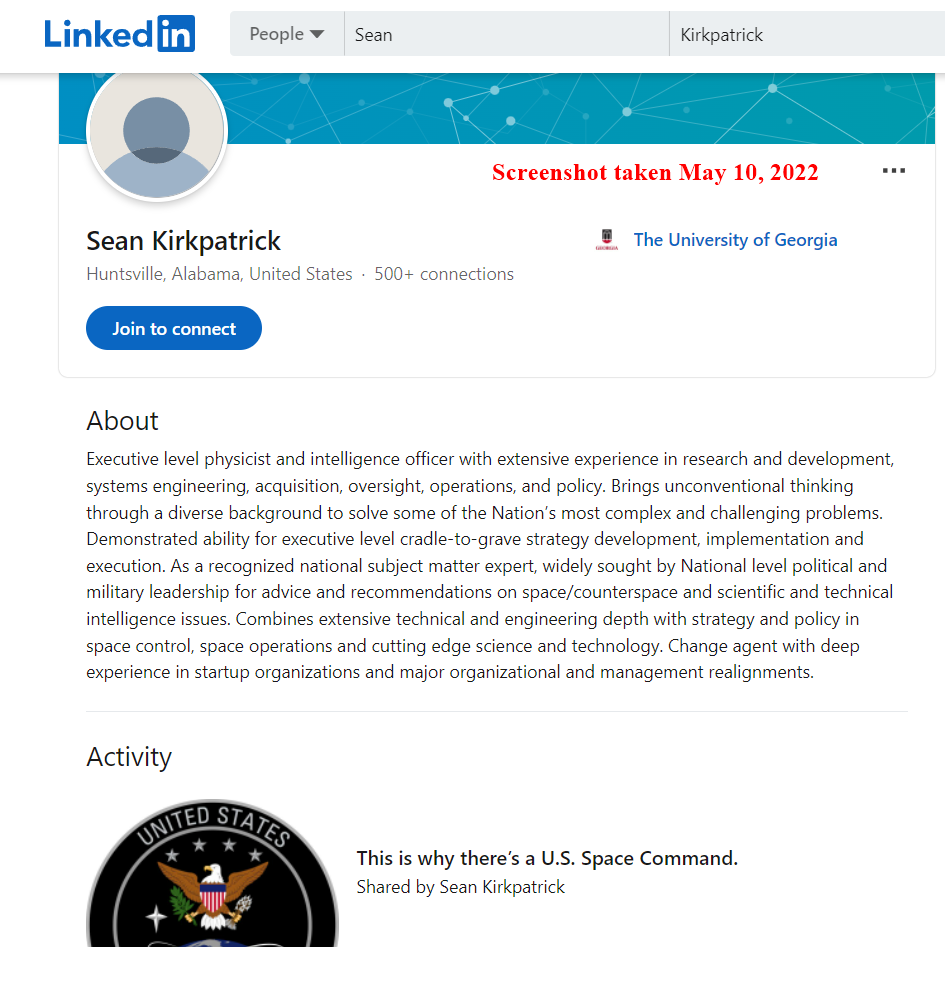
WHY THIS POSITION MATTERS
Under the provisions of the "Gillibrand-Rubio-Gallego" law enacted by Congress in December 2021 (National Defense Authorization Act, Public Law 117-81, Section 1683), "the head of the [UAP] office"– that is, the AOIMSG Director– will supervise key elements of the government's UAP-investigatory apparatus. AOIMSG initially was created by a directive from the Deputy Secretary of Defense on November 23, 2021, but its scope and resources were substantially expanded under the legislation signed into law on December 27, 2021, and the new enterprise was made subject to a formidable array of congressional mandates. The new provisions of law include these:
(2) INTELLIGENCE COLLECTION AND ANALYSIS PLAN.– The head of the Office [the AOIMSG director]...shall supervise the development and execution of an intelligence collection and analysis plan to gain as much knowledge as possible regarding the technical and operational characteristics, origins, and intentions of unidentified aerial phenomena, including with respect to the development, acquisition, deployment, and operation of technical collection capabilities necessary to detect, identify, and scientifically characterize unidentified aerial phenomena. (3) USE OF RESOURCES AND CAPABILITIES.—In developing the plan under paragraph (2), the head of the Office established...shall consider and propose, as the head determines appropriate, the use of any resource, capability, asset, or process of the Department and the intelligence community. (f) SCIENCE PLAN.—The head of the Office...shall supervise the development and execution of a science plan to develop and test, as practicable, scientific theories to—(1) account for characteristics and performance of unidentified aerial phenomena that exceed the known state of the art in science or technology, including in the areas of propulsion, aerodynamic control, signatures, structures, materials, sensors, countermeasures, weapons, electronics, and power generation; and (2) provide the foundation for potential future investments to replicate any such advanced characteristics and performance.
The AOIMSG Director will also be a key figure in preparing and presenting briefings and reports for designated congressional committees, including an annual unclassified report that will be made public (due annually by the end of October).
WHO IS DR. SEAN KIRKPATRICK?
Dr. Sean Kirkpatrick, who is about 53 years old, is an accomplished physicist with at least 58 published scientific papers, many of these dealing with optical properties and other properties of various natural and artificial materials, including at least two papers dealing with possible engineering applications of the infrared-sensing tissue utilized by pit vipers to find their prey. In more recent years, he has served as a senior manager of high-level government programs involving the intersections of science and national security intelligence.
A biographical sketch that Dr. Kirkpatrick presumably approved appears on several websites, generally in association with appearances at events related to national security and space. That bio currently appears at this link, and it is also reproduced below as it appears on a different website. Those wishing to review a more detailed chronology of Dr. Kirkpatrick's association with various government agencies should refer to the bio. In this article I do not itemize that long and accomplished record, but merely highlight some elements that may be of particular interest.
According to the posted bio, "Dr. Kirkpatrick began his career in Defense and Intelligence related science and technology almost immediately out of graduate school." (He received his Ph.D. in 1995.) Over the years, Dr. Kirkpatrick has been deeply involved in scientific and management work with security-related government agencies, including the Navy Research Laboratory, Air Force Research Laboratory, National Reconnaissance Office, CIA, Office of the Secretary of Defense, STRATCOM, and SPACECOM. He has also held various important positions within the Defense Intelligence Agency, most recently as Senior Scientist at the Missile and Space Intelligence Center (MSIC) in Huntsville, Alabama.
I claim no expertise with regard to the intricacies of these positions and the scope of their responsibilities, but it seems quite clear that Dr. Kirkpatrick has been a key manager and technical expert in the highest echelons of the U.S. government's scientific and technical intelligence (S&TI) world. The bio lists numerous awards, including the National Intelligence Exceptional Achievement Award and the DIA Director's Award for Excellence.

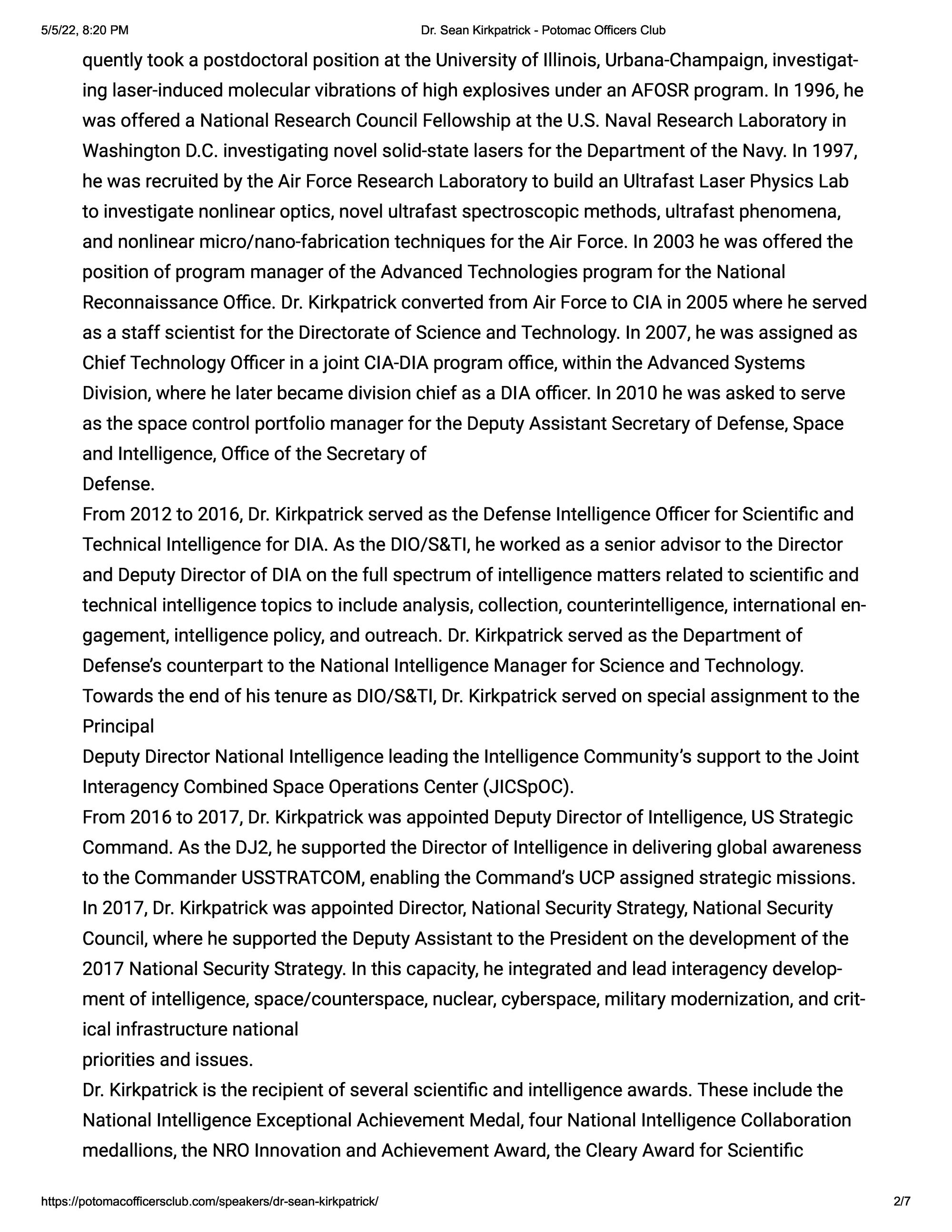
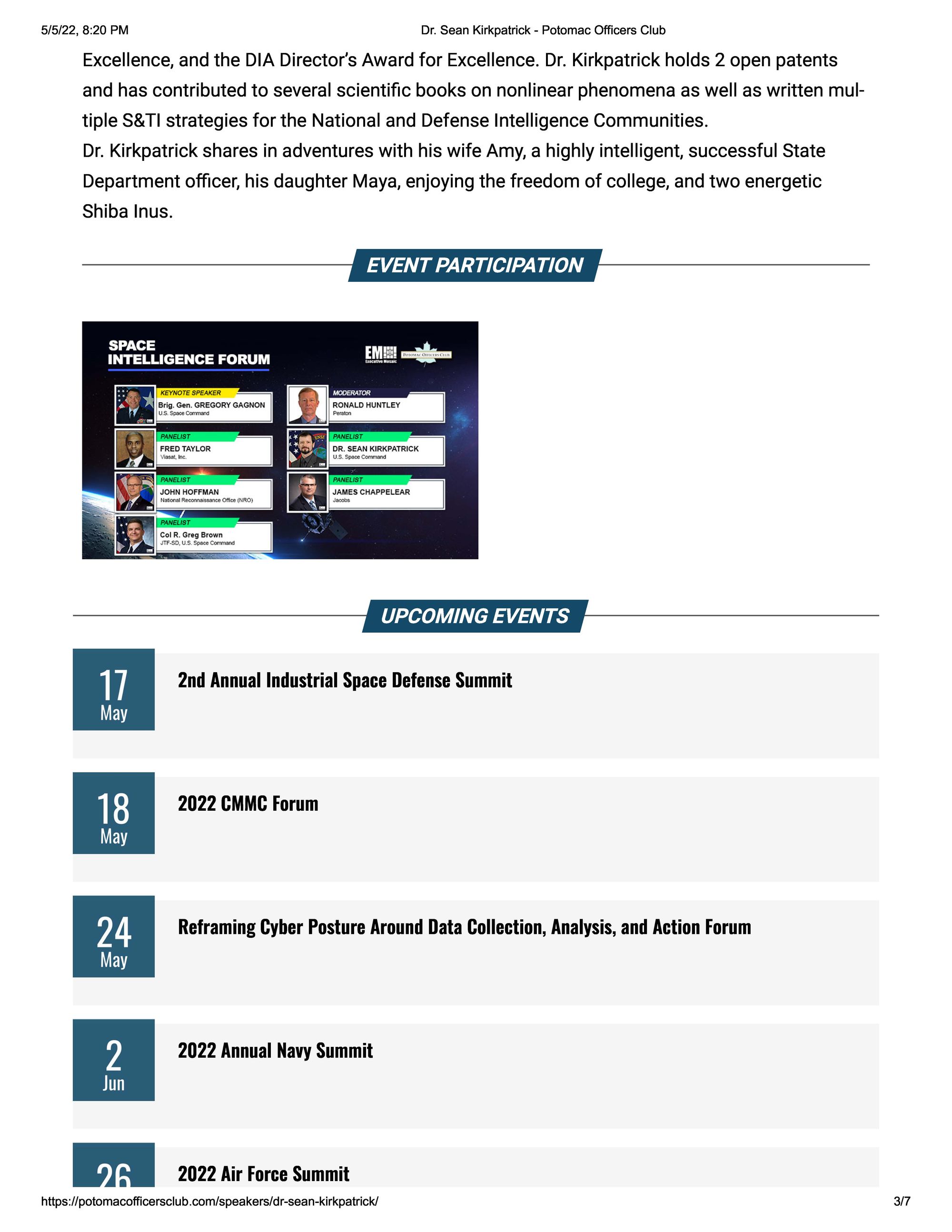
From 2012 to 2016, Dr. Kirkpatrick was the Defense Intelligence Officer for Scientific and Technical Assistance for the Defense Intelligence Agency (DIO/S&TI), making him "a senior advisor to the Director and Deputy Director of DIA on the full spectrum of intelligence matters related to scientific and technical intelligence topics to include analysis, collection, counterintelligence, international engagement, intelligence policy, and outreach." During this period, he gave an interview to Defense AT&L that is posted here; the magazine described his job as follows: "Dr. Kirkpatrick evaluates what our adversaries are doing and projects what that means to the United States." The article also mentioned that Dr. Kirkpatrick was "a level III program manager (PM) and has managed programs at the National Reconnaissance Office, the Air Force Research Laboratory and DIA." In the federal government, "Program Manager" is a certification for persons who oversee multiple projects, and "level III" is the highest level of such certification.
From 2016-2017, Dr. Kirkpatrick was Deputy Director of Intelligence (DJ2), U.S. Strategic Command (USSTRATCOM), which is the "unified combatant command" that is responsible for the the nation's nuclear strike forces, as well as the military's Global Information Grid (GIG).
In 2017, Dr. Kirkpatrick served as Director for National Security Strategy for the National Security Council (NSC), reporting to a Deputy Assistant to the President.
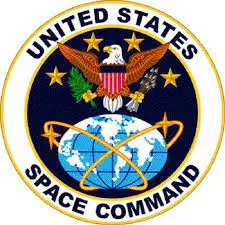
In August 2018, Dr. Kirkpatrick was appointed the Senior Intelligence Advisor to the Commander, Air Force Space Command and Joint Forces Space Component Command, USSTRATCOM, "charged by the DNI and the CDR/JFSCC to design the intelligence enterprise across and through the USPACECOM."
A 2021 document referred to Dr. Kirkpatrick as Deputy Director of Intelligence, J2 Intelligence Directorate, for U.S. Space Command (SPACECOM), and also SPACECOM's representative to the Office of the Director of National Intelligence (ODNI). SPACECOM is the Defense Department's "unified combatant command" that is responsible for national defense starting at 100 kilometers (62 miles) above mean sea level, and outward. SPACECOM has a status analogous to the geographically-delineated unified commands that are responsible for different surface regions, e.g., U.S. Indo-Pacific Command. SPACECOM should not be confused with the Space Force, which is a new uniformed service situated within the Department of the Air Force (but the Space Force is a distinct service from the Air Force). SPACECOM is staffed by officers from all of the uniformed services, including the Space Force, with the Space Force contribution expected to increase as that new service develops.
The Director of National Intelligence is a cabinet officer who oversees America's "Intelligence Community" (IC), which is made up of 18 different agencies, including the Central Intelligence Agency (which is not part of the Department of Defense).
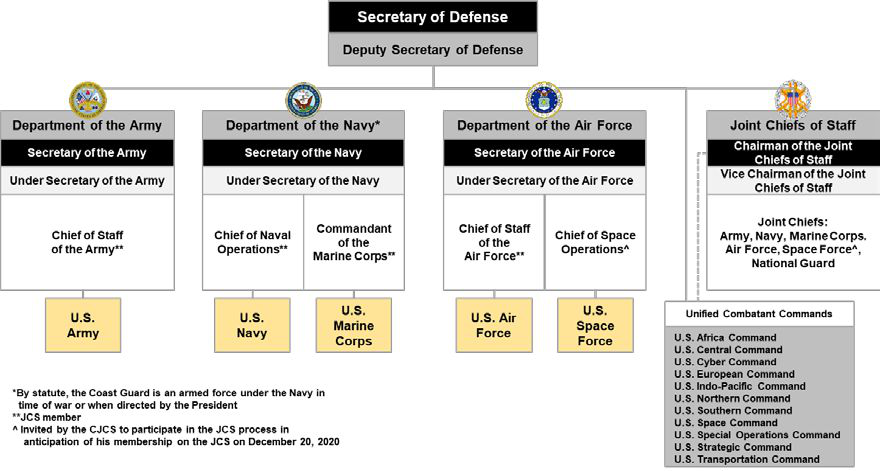
Dr. Kirkpatrick's most recent government post has been as Senior Scientist at the Missile and Space Intelligence Center (MSIC), based in Huntsville, Alabama. MSIC is a component of the Defense Intelligence Agency (DIA), which is a component of the Department of Defense. The specific mission of MSIC is to analyze, reverse-engineer, and counter air-and-space-related weapons systems of potential adversaries. Further down, I have embedded a video clip of Dr. Kirkpatrick representing MSIC before a group in March, 2022.
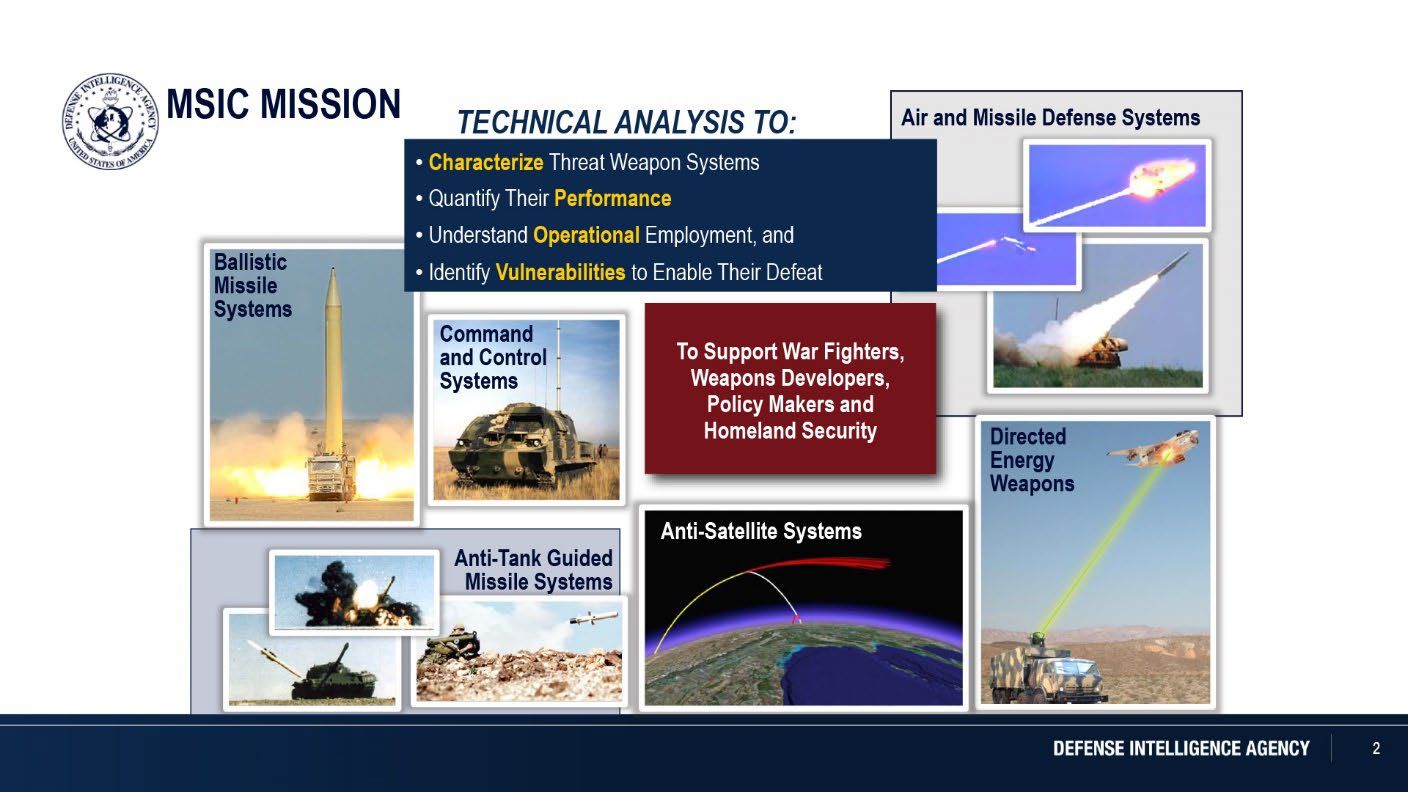
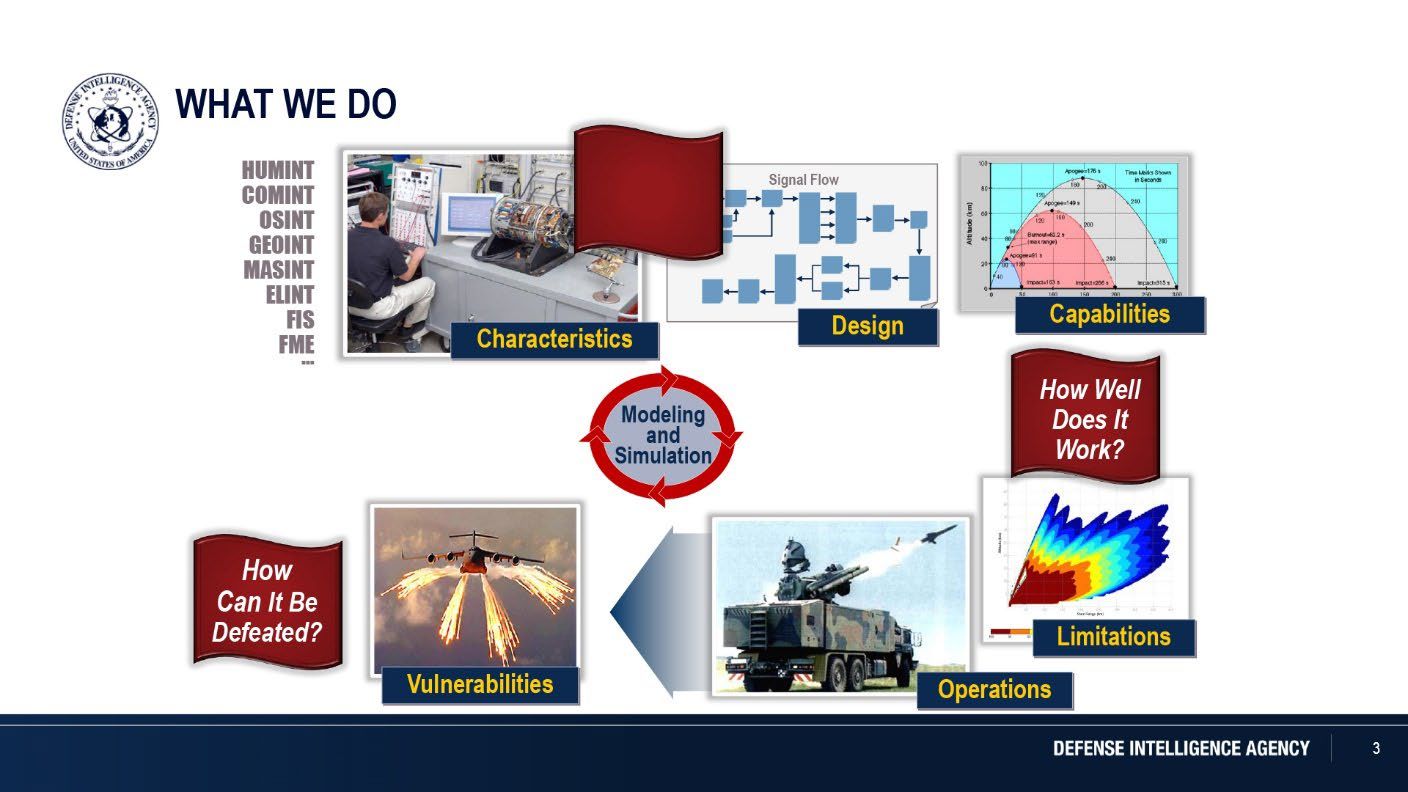
The DIA is only one part of the intelligence empire supervised by the Defense Department's top intelligence official, the Undersecretary of Defense for Intelligence & Security, currently Ronald S. Moultrie, a presidential appointee, confirmed by the U.S. Senate on May 29, 2021, by a voice vote (signifying that his nomination was not at all controversial). Undersecretary Moultrie is scheduled to testify on May 17, 2022 at a public hearing on unidentified aerial phenomena before a subcommittee of the House of Representatives Permanent Select Committee on Intelligence.

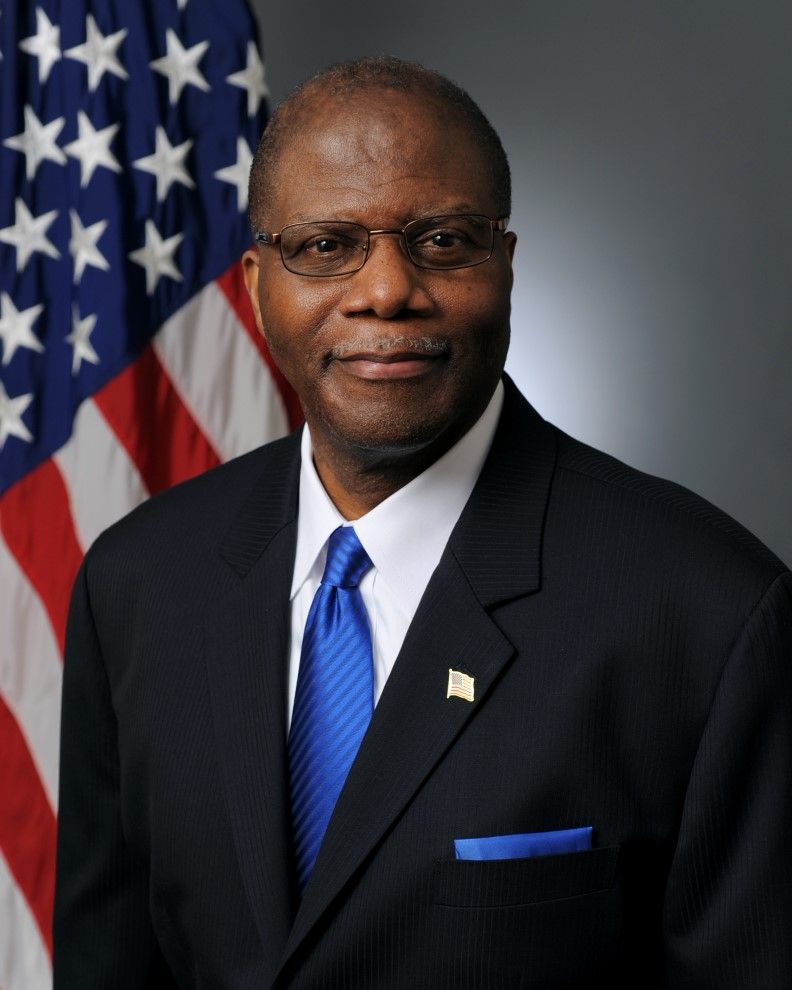
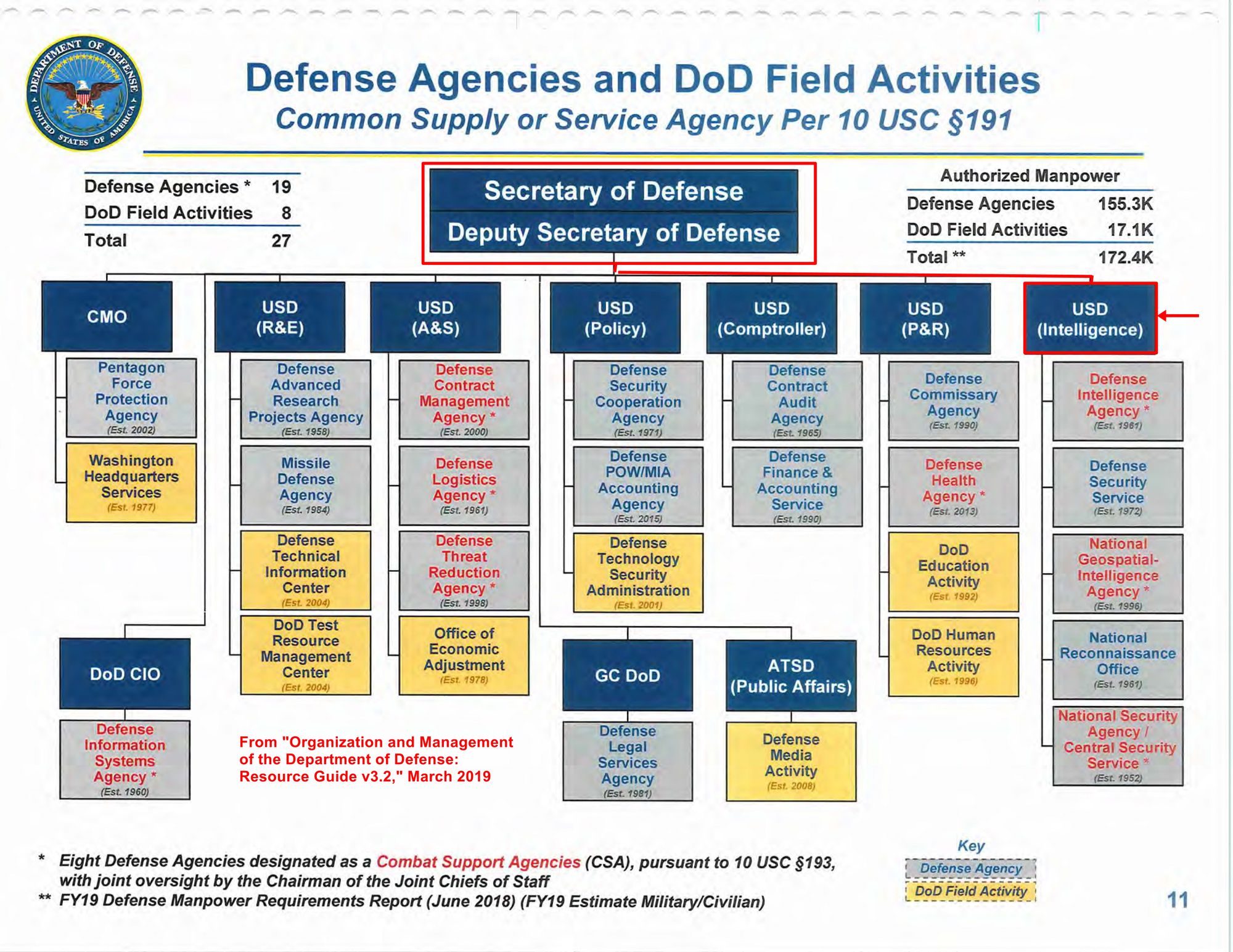
DR. SEAN KIRKPATRICK IN HIS OWN WORDS
Dr. Kirkpatrick seems to have a rather low profile on the internet, as one might expect a person who has spent a quarter-century working in the intelligence world. However, in recent years he has given a number of interviews and presentations for select audiences, mainly regarding space-based security issues.
For example, at a virtual conference sponsored by the Armed Forces Communications and Electronics Association (AFCEA) on April 13, 2021, appearing as the representative of the Director of National Intelligence to Space Command's Joint Task Force-Space Defense (JTF-SD), Dr. Kirkpatrick said, "I have to be able to see and metaphorically hear everything that's going on between 100 kilometers off the face of the planet to wherever we are, and right now we can't do that." He added that he is "worried about anything I can't see, hear, touch or attribute." (Dr. Kirkpatrick's remarks were quoted in an article titled "DoD Space Threat Intel Not Good Enough," by Theresa Hitchens, published on April 14, 2021.)
An article about the same forum that appeared in the magazine Signal, written by Kimberly Underwood, quoted Dr. Kirkpatrick's presentation at greater length.
"Their weaponization of space [referring to Russia and China], in the space domain, and to space from the ground, has really progressed significantly over the last 20 years,” Kirkpatrick says. “They have pursued nearly every type of counterspace weapon that you can think of and they have built them. They have tested them, and they are proliferating them in an operational environment. Everything from ground-based lasers to direct ascent antisatellite systems, to on orbit weapons, jammers, you name it, and if you can think of it, they've done it. And the fact that they are pursuing that really points to their understanding of the United States’ reliance on space in our daily lives.”
As the operational command in space, SPACECOM is responsible for providing the associated intelligence and operational intelligence analysis of what is occurring in the domain and reporting to a wide range of national security space partners across the Defense Department, the intelligence community, U.S. allies and commercial and civil partners, Kirkpatrick said.
"To do that, we have got to be able to see, characterize and attribute everything that is going on in space that we are operating in,” he explained. “The biggest challenge for us is any threat that I can't attribute, and I can't see what is happening or where it's coming from, whether that's nanosatellite that we didn't see was coming or a directed energy weapon that we didn't know where it was, or a cyberattack, any of those can be catastrophic. And it can be really difficult for us to understand what is happening and then point to somebody and say they are the ones doing it.”
A report in Air Force Magazine by Amanda Miller quoted remarks by Dr. Kirkpatrick at a May 7, 2021 Space Foundation virtual event:
To be in position to gather intelligence in deep space soon enough, U.S. Space Command’s Deputy Director of Intelligence physicist Sean M. Kirkpatrick said the U.S. needs to take advantage of space technology the commercial sector is already working on.
“We’ve got a huge moon competition going on. We’ve got a Mars competition going on—multiple countries heading out,” Kirkpatrick said. “We are going to have to extend our mission space to the cislunar, lunar, and Martian orbits and regimes at some point in the not-too-distant future.”
The customary five- to 10-year timeframe for a defense acquisition program would take too long, he said:
“We’re going to be far behind…So we need to look forward now on, ‘What do I have to put in cislunar orbit, or [what] do I need to put in lunar orbit, just to be able to monitor activities that are going on and report that back?’”
WHAT IS AOIMSG?
The Airborne Object Identification and Management Synchronization Group (AOIMSG) was originally established by direction of the second-ranking official of the Department of Defense, Deputy Secretary of Defense Kathleen Hicks, in a memorandum dated November 23, 2021. At the moment that memorandum was issued, two far-reaching UAP-related legislative proposals were moving forward in Congress, each to require creation of a Pentagon-IC entity to deal with UAP, and each to place very specific mandates upon that entity– requirements far broader than those contemplated in the Hicks memorandum.
The first proposal, authored by Congressman Ruben Gallego (D-Az.), passed the House of Representatives on September 23, 2021. The second, considerably more robust and proscriptive, was introduced by Senator Kirsten Gillibrand (D-NY) on November 4, 2021. I was the first to report on its introduction, with an article on this blog on November 5, 2021, and corresponding tweets. The Gillibrand amendment was soon co-sponsored by several key members of both parties, including Senator Marco Rubio (R-Fl.), the ranking Republican on the Senate Select Committee on Intelligence, a prime mover on previous UAP-related initiatives. The language went through several rounds of minor refinements over a period of several weeks.
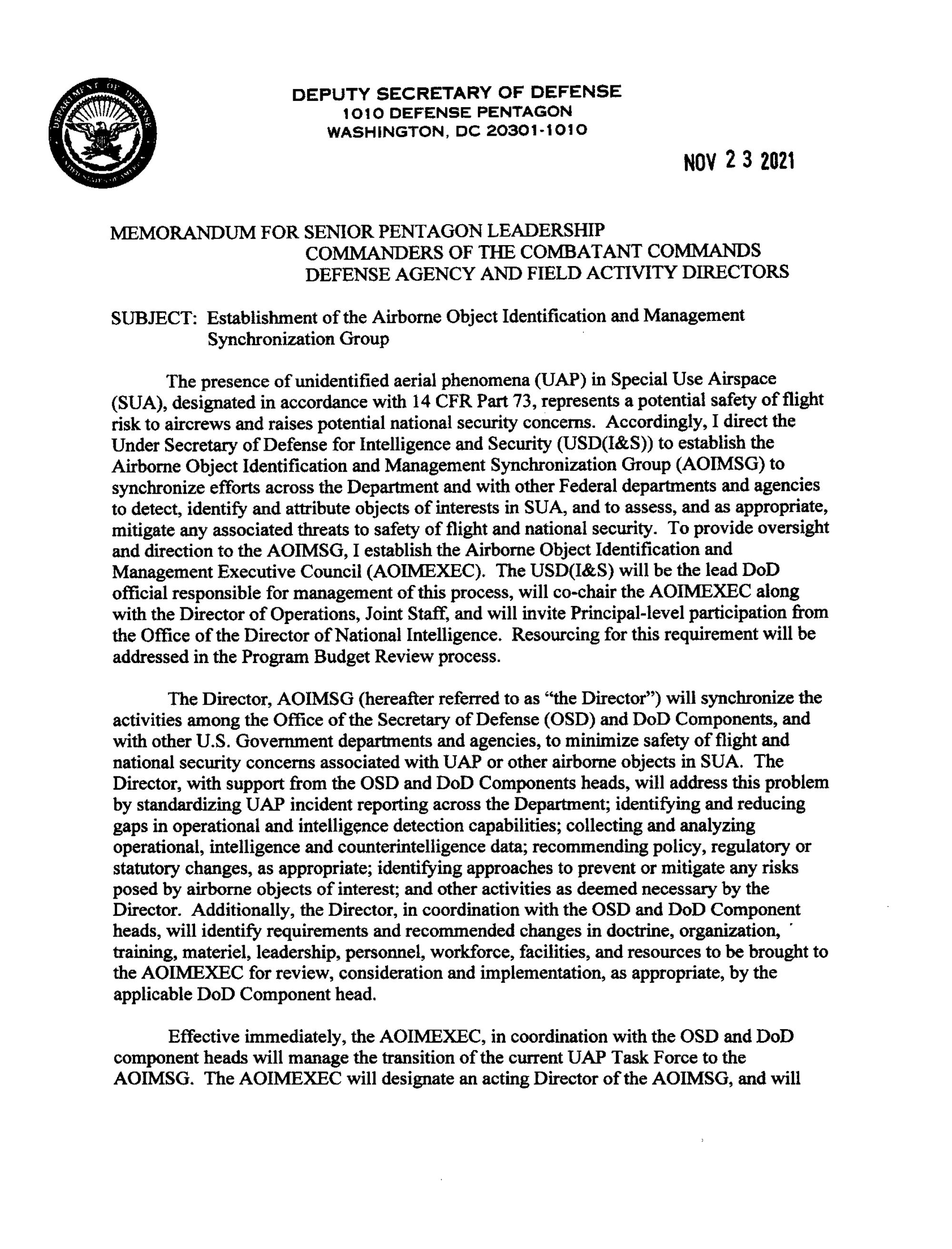

When the Hicks memo was released on November 23, 2021, I immediately commented on Twitter, "[The] Hicks memo was released yesterday at moment exquisitely calculated to maximize chances of derailing negotiations over Gillibrand-Rubio." I even suggested that "AOIMSG" might really stand for "An Office Intended Mainly to Stop Gillibrand." The memo was clearly intended by some factions in the Pentagon to convey to key lawmakers something along the lines of "we're already dealing with this, so please don't enact legislation imposing all those sweeping and specific mandates."
However, that effort at derailment was unsuccessful. After closed-door negotiations primarily involving members of the Senate and House armed services committees and their professional staffs, seeking to reconcile the significantly different Gallego and Gillibrand-Rubio texts, robust UAP-related compromise language emerged on December 7, 2021. I dubbed this final text the "Gillibrand-Rubio-Gallego" language. On the same day it was unveiled, I described and analyzed the unprecedented language in a detailed article on this blog.
My December 7, 2021 article remains accurate– nothing in the legislative language was altered in any way prior to its enactment on December 27, 2021, when President Biden signed the Fiscal Year 2022 National Defense Authorization Act (now Public Law 117-81). Images of the actual pages of the UAP-related section (Section 1683) from the final ("enrolled") bill may be downloaded here.
(On March 15, 2022, the FY 2022 Intelligence Authorization Act was also belatedly enacted, as part of an omnibus funding bill that became Public Law 117-103; this legislation included a couple of modest new UAP-related requirements, while diluting nothing from the UAP-related provisions enacted in the NDAA two months earlier. I summarized the content of the IAA-linked provisions and their significance in a tweet-chain at the time of its enactment. The complete UAP-related legislative language enacted as part of this IAA package can be downloaded here.)
The major UAP law enacted in December 2021 places ultimate responsibility for fulfillment of the extensive congressional requirements squarely on the Secretary of Defense, shared with the Director of National Intelligence. However, in the hierarchical scheme of the huge Department of Defense, the implementation of the law falls primarily under the purview of the Undersecretary of Defense for Intelligence & Security (currently Ronald S. Moultrie), his deputy David M. Taylor, and the occupant of a subordinate but key office mandated by the law itself– the Director of the new UAP-activity coordinating office (currently branded AOIMSG). It is this last position that Dr. Kirkpatrick will fill.
THE NEW UAP LAW
The Gillibrand-Rubio-Gallego law, enacted as part of the FY 2022 National Defense Authorization Act (NDAA), was the first time that Congress had ever enacted any legislation dealing specifically with unidentified flying objects, by any terminology (although the subject had been the subject of directive language in several committee reports in recent years). Regarding the significance of this development, some highlights from my December 7, 2021 article:
The proposed new law would radically change the statutory terrain on which the Department of Defense and intelligence agencies (collectively the "Intelligence Community," or IC) operate with respect to UAP. By enactment, Congress would clearly set forth explicit statutory mandates, and place accountability for carrying them out squarely on the shoulders of the Secretary of Defense ("Secretary"), shared in some measure with another cabinet-level officer, the Director of National Intelligence (DNI).
Among the functions of the central UAP office would be the following: "Developing procedures to synchronize and standardize the collection, reporting, and analysis of incidents, including adverse physiological effects, regarding unidentified aerial phenomena across the Department of Defense and intelligence community.... Evaluating links between unidentified aerial phenomena and adversarial foreign governments, other foreign governments, or nonstate actors....Evaluating the threat that such incidents present to the United States.... Coordinating with other departments and agencies of the Federal Government, as appropriate, including the Federal Aviation Administration, the National Aeronautics and Space Administration, the Department of Homeland Security, the National Oceanic and Atmospheric Administration, and the Department of Energy....Coordinating with allies and partners of the United States, as appropriate, to better assess the nature and extent of unidentified aerial phenomena." [...]
While the central office would exercise oversight authority and play a coordinating function, key provisions require that the Secretary of Defense and DNI designate "line organizations" – major military and/or IC components – to conduct the operational aspects of UAP investigations. It requires that these organizations have the capacity "to rapidly respond to, and conduct field investigations of" UAP incidents. The bill requires that these line organizations have access to "adequate personnel with requisite expertise, equipment, transportation, and other resources necessary to respond rapidly to incidents or patterns of observations" of UAP.
The GRG ["Gillibrand-Rubio-Gallego"] text also requires the director of the Pentagon UAP office to supervise development of a "science plan to develop and test, as practicable, scientific theories to account for characteristics and performance of unidentified aerial phenomena that exceed the known state of the art in science or technology, including in the areas of propulsion, aerodynamic control, signatures, structures, materials, sensors, countermeasures, weapons, electronics, and power generation," and to try "to replicate any such advanced characteristics and performance; and provide the foundation for potential future investments to replicate any such advanced characteristics and technology."
The language mandates that the Secretary and the DNI "shall ensure that each element of the intelligence community with data related to unidentified aerial phenomena makes such data available immediately" to the UAP office. To help enforce that decree, the bill requires that at least twice a year, "the Chairman and Vice Chairman or Ranking Member of the Committee on Armed Services and the Select Committee on Intelligence of the Senate and the Committee on Armed Services and the Permanent Select Committee on Intelligence of the House of Representatives shall receive an enumeration of any instances in which data related to unidentified aerial phenomena was denied to the Office because of classification restrictions on that data or for any other reason." [This enumeration is to be provided by the director of the UAP office.]
STAFFING THE NEW UAP OFFICE
The Pentagon has not yet produced any detailed explanation of how it intends to structure or staff the new UAP enterprise. Nor has it named the "line organizations" that the law requires to be designated to perform the field investigations, analysis, and other resource-heavy operations mandated by Congress. The law requires the Director of National Intelligence ("in consultation with" the Secretary of Defense) by October 31, 2022 to submit reports to designated congressional committees, in both classified and unclassified form, that among many other specific items must include "the names of the line organizations that have been designated to perform" these mandated functions.
On May 10, 2022, chief Pentagon spokesperson John F. Kirby, in response to a question from Howard Altman of The War Zone during a general press briefing, said, "I don't have an update for you on the UAP group that you're talking about. We're still working to sufficiently staff that organization and get them into a battle rhythm."
In early May, 2022, a number of social-media accounts and news media outlets recently took note of job notices, posted on several government websites, for two senior-level staff positions at AOIMSG, "Senior Analysis Lead" and "Collection Lead." As described, the persons who fill these positions would be performing certain functions "on behalf of the Director of the Airborne Object Identification and Management Synchronization Group (AOIMSG)."
For both of the jobs, eligibility was limited to persons already employed within the Intelligence Community, with (at least) GG/GS-15 rank (a civil-service pay grade equivalent to an Army colonel or Navy captain), and already holding active Top Secret / SCI [Sensitive Compartmented Information] security clearances. Approval by the applicant's currently employing agency was also required, with the loan to AOIMSG to run for 24 months. In the initial notice for both jobs, the "vacancy open date" was March 16, 2022; the "vacancy close day" was April 15, 2022, and the "start date" was April 26, 2022. However, as of May 10, 2022, the website of the Director of National Intelligence had re-listed the "AOIMSG Senior Analysis Lead" position, now with a "vacancy close date" of May 13, 2022, and a "start date" of May 24, 2022.


Oddly, the two job notices contained terminology that in some respects tracked the November 27, 2021 Hicks memorandum, rather than the more expansive requirements enacted by Congress as part of the FY 2022 National Defense Authorization Act. For example, the job notices said that AOIMSG "synchronizes DoD efforts to detect, identify and attribute objects of interest in Special Use Airspace..." [italics added for emphasis] The term "Special Use Airspace" refers to air space which the military or other government agencies have reserved for specific uses, generally disallowing or substantially restricting any other air traffic. AOIMSG's purview was described as applying to Special Use Airspace in the Hicks memo – but the law subsequently enacted by Congress contained no language limiting its UAP-related mandates to Special Use Airspace.
Moreover, the Pentagon continues to cling to the name for the office that it unveiled in the November 27, 2021 Hicks memo (Airborne Object Identification and Management Synchronization Group), even though the NDAA enactment explicitly expanded the scope of the enterprise beyond solely "airborne object[s]." The law explicitly also covers any "objects or devices that are observed to transition between space and the atmosphere, or between the atmosphere and bodies of water, that are not immediately identifiable."

On March 24, 2022, Dr. Kirkpatrick, in his capacity as Senior Scientist for the DIA's Missile and Space Intelligence Center (MSIC), gave a short talk and slideshow to an audience of defense-industry representatives, at which he responded to a question about what sorts of qualifications a private firm would need to possess to do business with the MSIC. Although the question was specific to the MSIC, Dr. Kirkpatrick's answer– which you can hear in this video clip– might have some application to private enterprises that think they may have something to offer to the AOIMSG.
EARLIER LIFE AND SCIENTIFIC WORK
I am not sure how much online personal-life information about career intelligence officers, scrubbed as it may be, can be relied upon as to precise details, but Dr. Kirkpatrick's boilerplate bio says he was born in Columbus, Georgia "to an Army family," and that he grew up "in the Atlanta area." It appears that he was born in or around 1968. The bio notes that he "shares adventures with his wife Amy, a highly intelligent, successful State Department officer, his daughter Maya... and two energetic Shiba Inus," that last being a breed of hunting dog from Japan.

Kirkpatrick attended the University of Georgia both as an undergraduate and as a graduate student. He received his Ph.D. in physics in 1995. His Ph.D. work was "in nonlinear and nonequilibrium phonon dynamics of rare earth doped fluoride crystals." Dr. Kirkpatrick has maintained status as an adjunct assistant professor of physics in the Department of Physics and Astronomy at the University of Georgia.
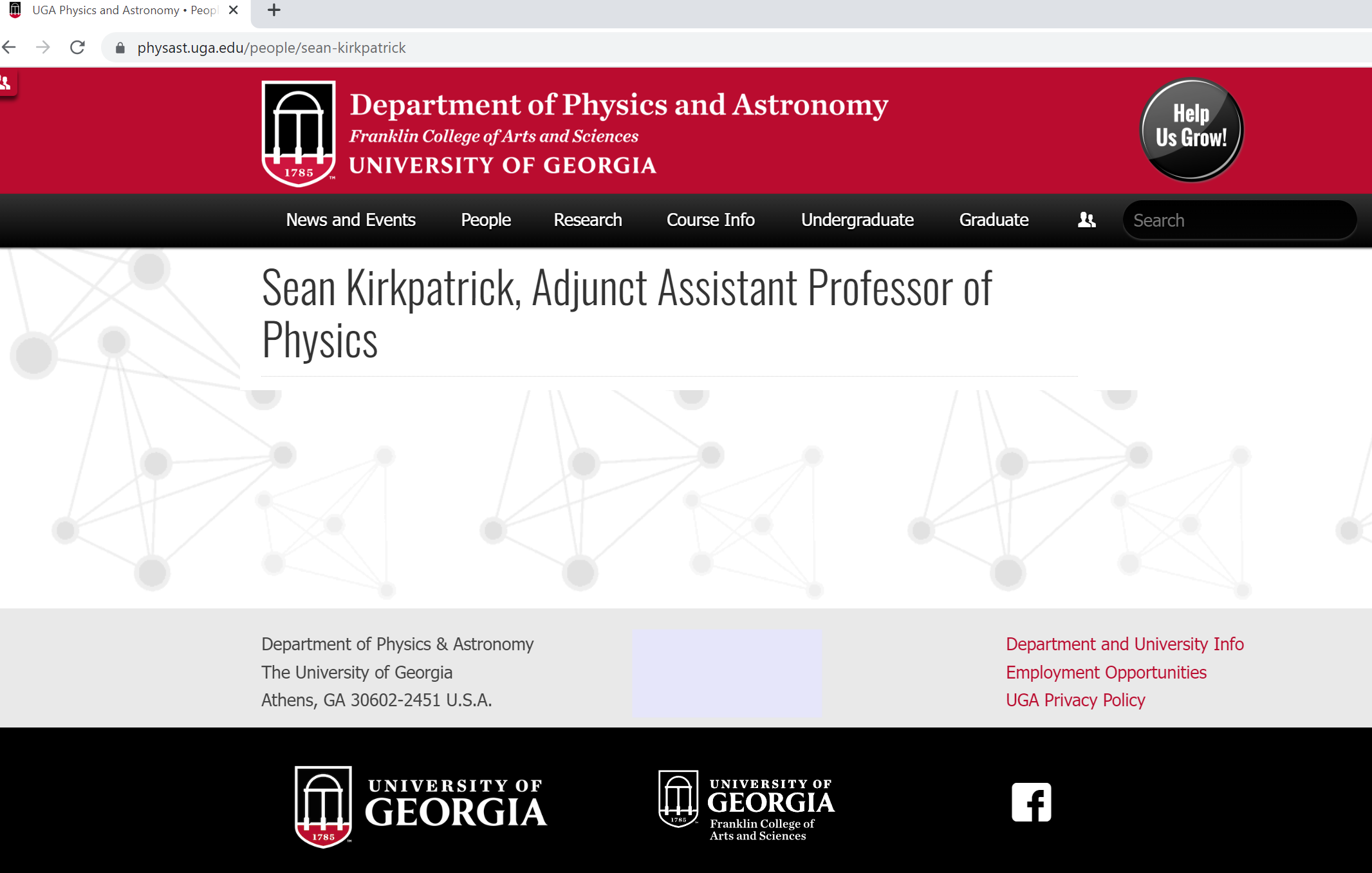
Dr. Kirkpatrick has authored or co-authored many scientific papers. The website researchgate.com lists him as a co-author on 58 papers from 1994 to 2011. The subjects of these papers are highly technical. Many of them seem to deal with optical and electrical attributes of various artificial and biological materials, including some studies that fall within the field of biomimetics (the study of systems evolved in the biological world that might be applicable in human engineering). For example, two papers dealt with "mimicking the natural infrared detection structures found in certain snake pit tissue," referring to the specialized sensor organs that pit vipers (such as rattlesnakes) use to locate prey.
If even one-third of the stories about past intra-government infighting over UAP-related matters are true, familiarity with snake pits might not be bad preparation for full-time work, within the government, investigating Unidentified Aerial Phenomena.
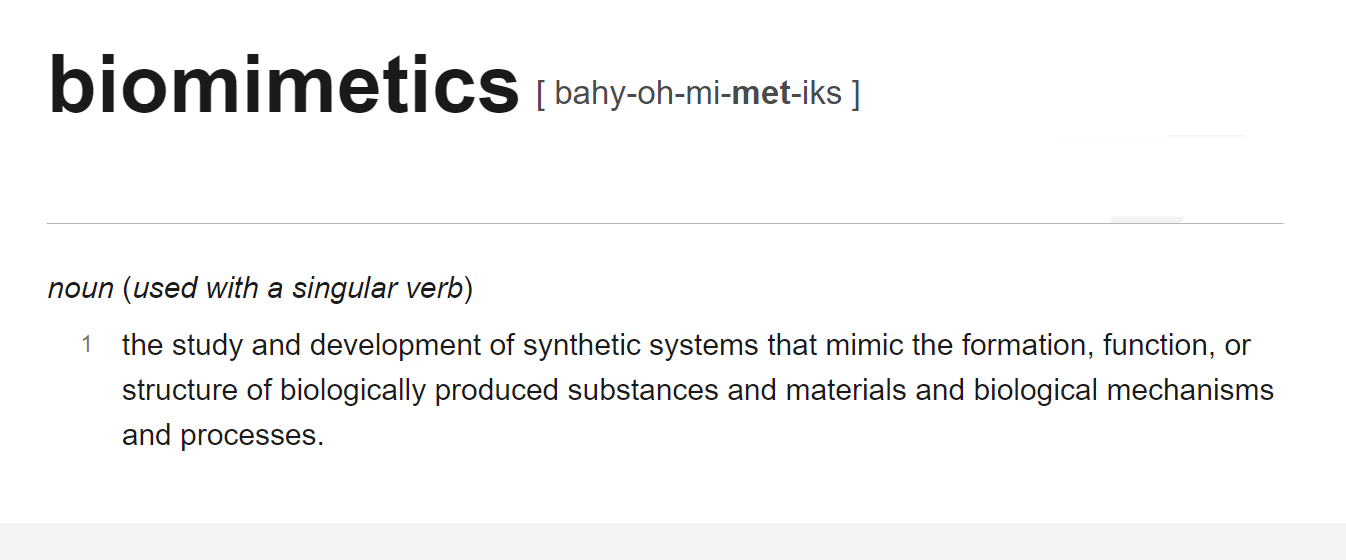


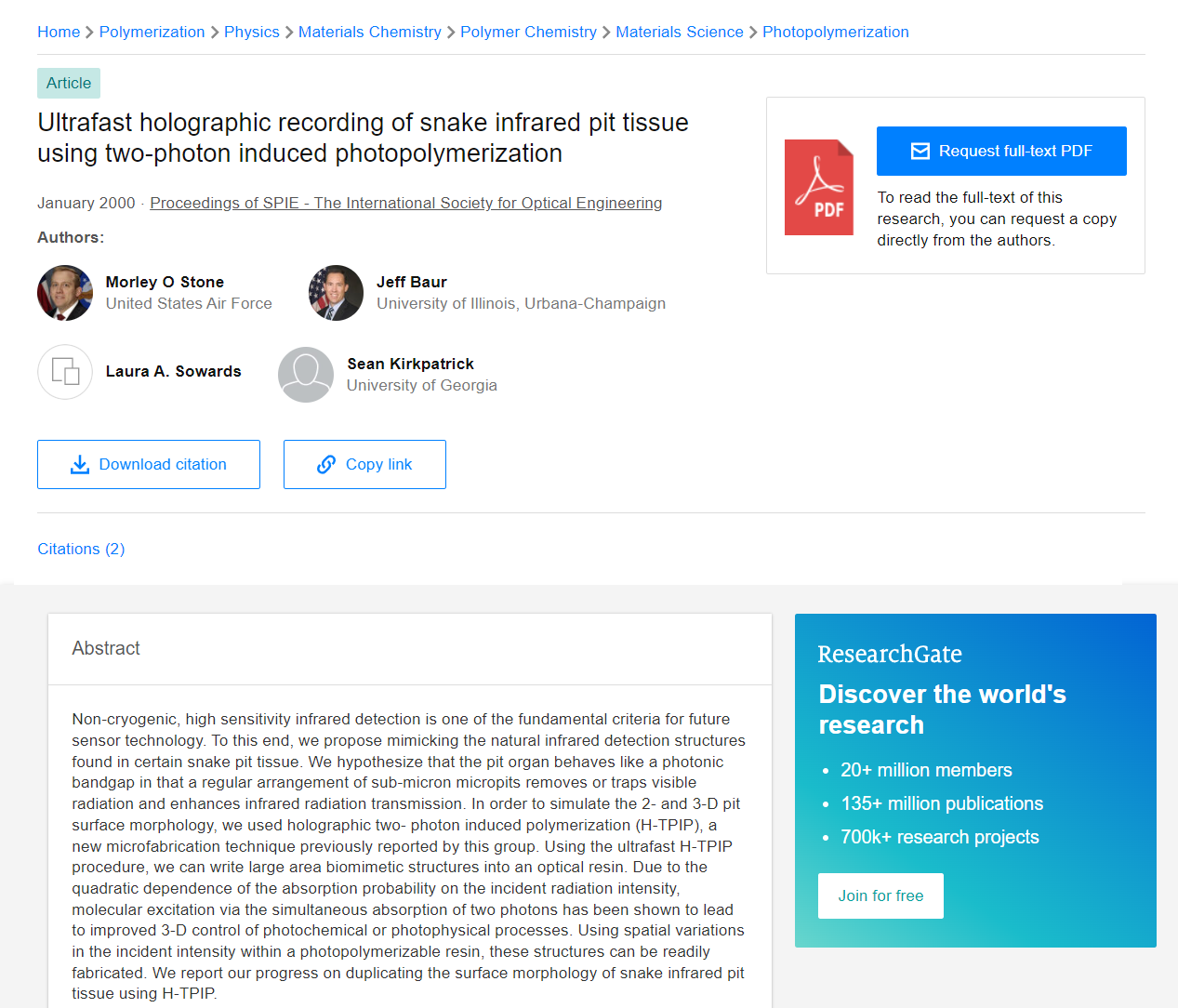
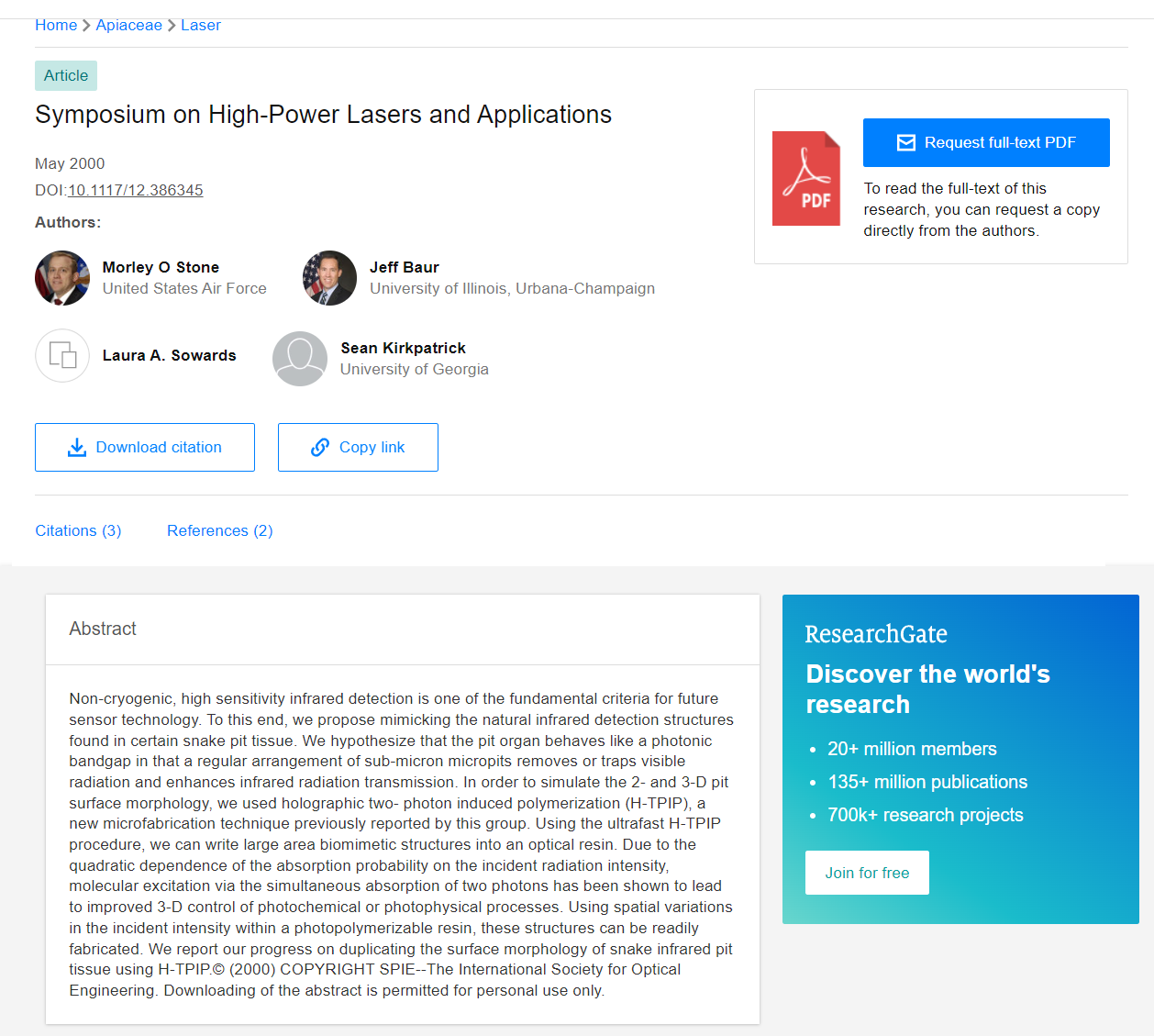
This is a developing story. I hope to report on additional details in the months to come, both on this blog and through my UAP-oriented Twitter account, @ddeanjohnson.
My gmail address is my full name (firstname-dot-middlename-dot-lastname).
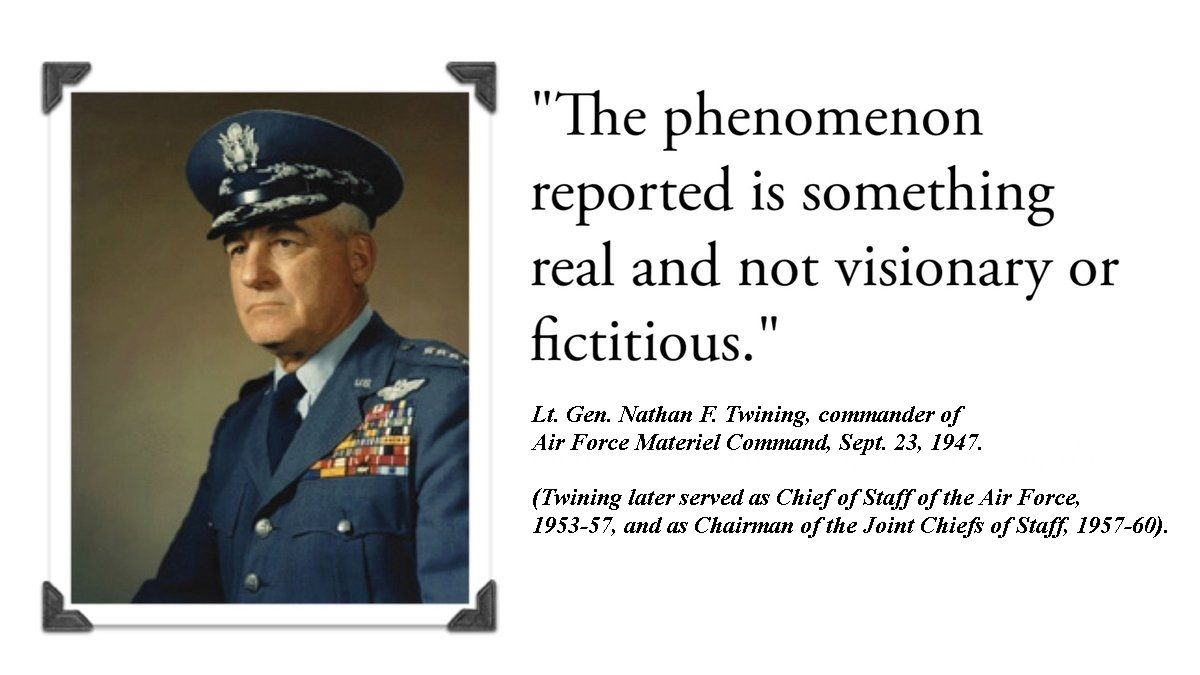
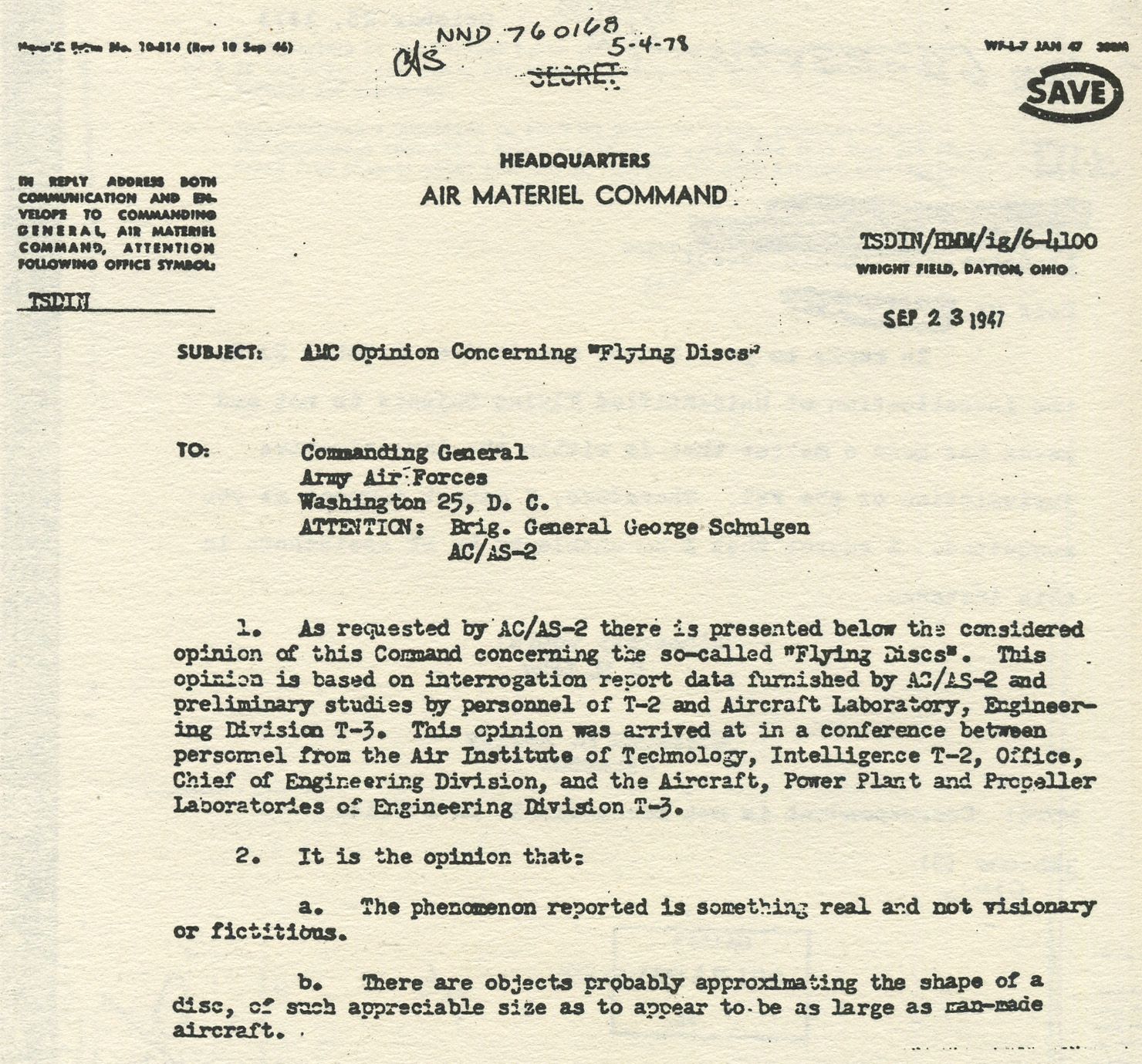
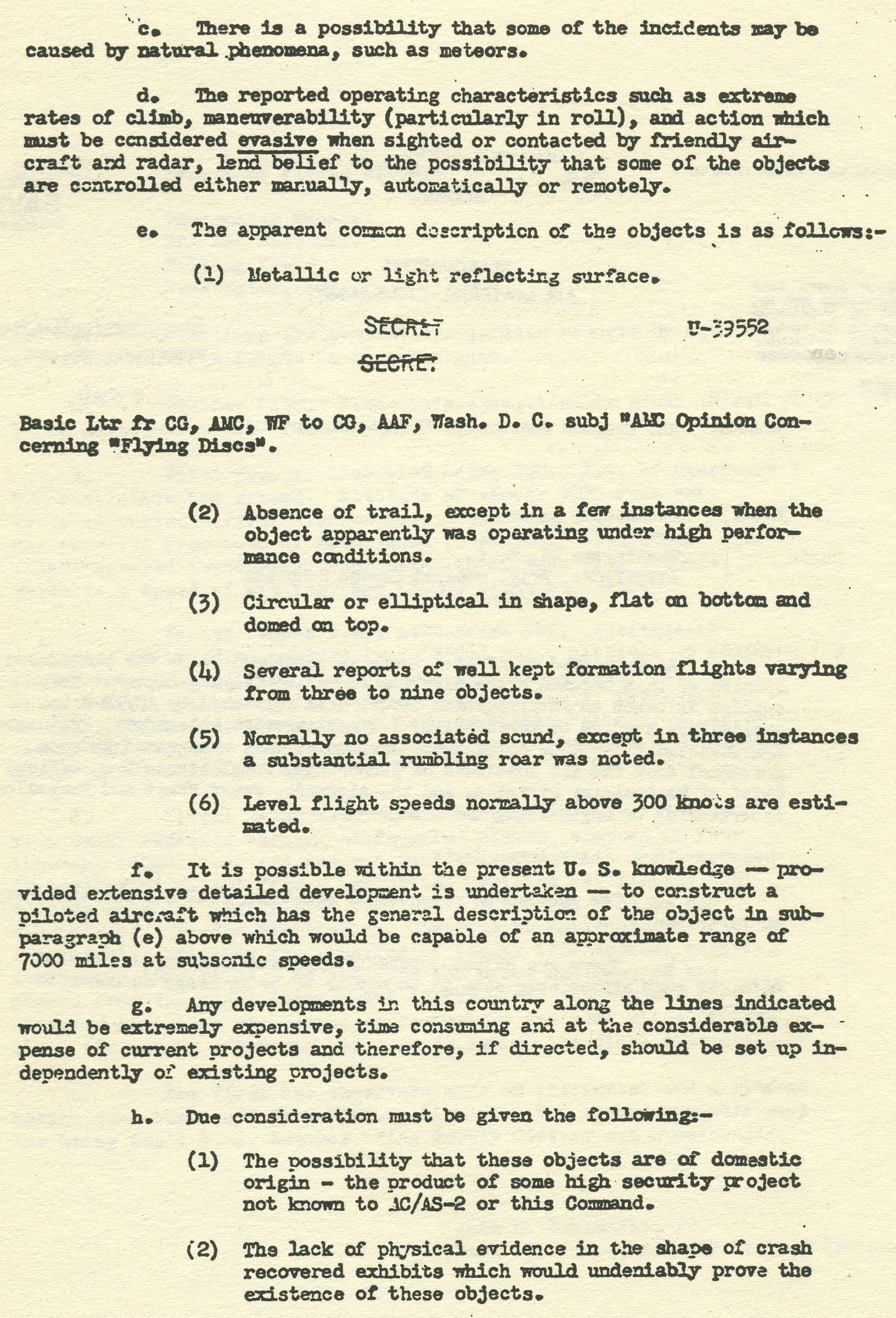

Substantive edits to this article since it was originally posted on May 12, 2022:
- May 17, 2022: added bracketed paragraph noting a statement by Department of Defense Under Secretary for Intelligence & Security Ronald Moultrie, at a congressional hearing on that date, that he had picked "a very established and accomplished individual" as director of the new UAP office; and reporting on a follow up response from Pentagon spokeswoman Susan Gough, stating that Mr. Moultrie's pick "is still undergoing the sometimes lengthy hiring process for executives," and that "we can't comment on the individual or confirm any names at this time."
- July 22, 2022: added bracketed paragraph quoting press Pentagon press release confirming Dr. Kirkpatrick's selection to head the Pentagon UAP office. An attached bio of Dr. Kirkpatrick said he was asked in early 2022 "to stand-up and lead" the office.
- On December 16, 2022, the Pentagon press office held a "media roundtable" with Ronald Mountrie, Under Secretary of Defense for Intelligence and Security, and Dr. Sean Kirkpatrick, director of the All-domain Anomaly Resolution Office (AARO). A transcript of that event may be accessed here.
- On January 11, 2023, Dr. Sean Kirkpatrick gave a presentation to the Transportation Research Board, a component of the National Academy of Engineering, on the topic "The Defense Department's UAP Mission & Civil Aviation." No transcript or video of the presentation has been posted, but an associated set of slides was made available and is embedded below.